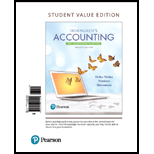
The amount of cash available after the deducting the expected capital expenditure is called free cash flow. Free cash flow represents the financial flexibility of a company.
Cash Flow from operating activities:
The cash generated from the operating activities of the business is called cash flow from operating activities.
Cash flow from investing activities:
Cash flow from generated or used in investing activities such as capital investment or short term investment are called cash flow from investing activities.
Cash flow from financing activities:
The cash generated or used in financing activities like issue of shares, debentures or repayment is called cash flow from financing activities.
To determine:
1. What is the financial focus of Amazon.com, Inc. What are free
2. What type of non-cash adjustments was made to net income stated in statement of cash flow from the Amazon.com report in 2015?
3. What was the net cash provided (used) for investing activities? What were the
4. What was the net cash provided (used) for financing activities? What were the cash inflows and outflows related to this section?
Want to see the full answer?
Check out a sample textbook solution
Chapter 16 Solutions
Horngren's Accounting: The Managerial Chapters, Student Value Edition (12th Edition)
- Please show me how to solve this financial accounting problem using valid calculation techniques.arrow_forwardCould you help me solve this financial accounting question using appropriate calculation techniques?arrow_forwardCan you explain this general accounting question using accurate calculation methods?arrow_forward
- how much overhead cost would be assigned to product G98X using the activity based costing system ?arrow_forwardThe closing price of a stock is $74.55, and the net earnings per share are $3.50. The stock's P/E ratio is .arrow_forwardI need guidance with this general accounting problem using the right accounting principles.arrow_forward

 AccountingAccountingISBN:9781337272094Author:WARREN, Carl S., Reeve, James M., Duchac, Jonathan E.Publisher:Cengage Learning,
AccountingAccountingISBN:9781337272094Author:WARREN, Carl S., Reeve, James M., Duchac, Jonathan E.Publisher:Cengage Learning, Accounting Information SystemsAccountingISBN:9781337619202Author:Hall, James A.Publisher:Cengage Learning,
Accounting Information SystemsAccountingISBN:9781337619202Author:Hall, James A.Publisher:Cengage Learning, Horngren's Cost Accounting: A Managerial Emphasis...AccountingISBN:9780134475585Author:Srikant M. Datar, Madhav V. RajanPublisher:PEARSON
Horngren's Cost Accounting: A Managerial Emphasis...AccountingISBN:9780134475585Author:Srikant M. Datar, Madhav V. RajanPublisher:PEARSON Intermediate AccountingAccountingISBN:9781259722660Author:J. David Spiceland, Mark W. Nelson, Wayne M ThomasPublisher:McGraw-Hill Education
Intermediate AccountingAccountingISBN:9781259722660Author:J. David Spiceland, Mark W. Nelson, Wayne M ThomasPublisher:McGraw-Hill Education Financial and Managerial AccountingAccountingISBN:9781259726705Author:John J Wild, Ken W. Shaw, Barbara Chiappetta Fundamental Accounting PrinciplesPublisher:McGraw-Hill Education
Financial and Managerial AccountingAccountingISBN:9781259726705Author:John J Wild, Ken W. Shaw, Barbara Chiappetta Fundamental Accounting PrinciplesPublisher:McGraw-Hill Education





